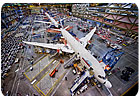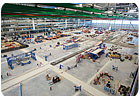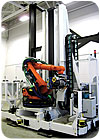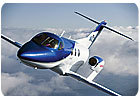
Commercial aerospace manufacturers are throttling up production. In recent months, some of the industry’s leading companies have either opened or announced plans to build new assembly lines that use state-of-the-art production tools and techniques.
The industry is investing more than $1 billion in manufacturing facilities. During the recent Paris Air Show, aerospace executives predicted bright skies ahead for the industry. For instance, Boeing Commercial Airplanes foresees demand for 33,500 new passenger airplanes and freighters between 2011 and 2030.
“The world market has recovered and is now expanding at a significant rate,” claims Randy Tinseth, vice president of marketing at Boeing Commercial Airplanes. “Not only is there a strong demand for air travel and new airplanes today, but the fundamental drivers of air travel-including economic growth, world trade and liberalization-all point to a healthy long-term demand.”
“Worldwide interest in new-generation technology with improved operating efficiencies, passenger comfort and a reduced environmental impact, paired with expected economic growth in developing markets, will drive the demand for new commercial aircraft,” predicts Guy Hachey, president and CEO of Bombardier Aerospace.
“Overall industry projections reflect the need for about 1,500 new aircraft per year for the next 20 years,” adds Scott Thompson, U.S. aerospace and defense leader at Pricewaterhouse Coopers LLC. “Current production levels are about 1,000 planes, so the increased demand would support a 50 percent increase in production.” However, Thompson believes the industry will keep some cushion between demand and production as a hedge against potential future downturns.

Increased Capacity
According to long-time industry observer, Richard Aboulafia, more capacity is coming on line to meet market needs. “Civil jetliners are the only major part of the world economy that actually grew through the recession,” he points out. “They continue to outperform any other part of the economy, largely due to the availability of third party finance and high fuel prices, which increase the appeal of new equipment.“The new facilities I’ve been in are remarkable,” says Aboulafia, vice president of analysis at Teal Group Corp. “They’re clean, quiet, and capital-intensive, with much less touch-labor involved.”
One of the challenges that aerospace manufacturers face is that the systems and parts used are highly complex, while production volumes are very low. The industry produces 1,000 large planes per year compared to other industries where annual volumes are measured in the tens of millions.
As a result, facilities have a more manually intensive environment. “However, the industry has made some impressive improvements in productivity in the past decade, including the digitization of engineering and production, and automation in manufacturing and assembly,” says Thompson. “These technologies will continue to enhance existing facilities and will certainly be incorporated into new facilities.”
According to Thompson, one of the biggest differences in new vs. old aerospace assembly plants is production flow. New facilities have been designed around lean manufacturing and production flow. Materials and subassemblies are received at one end of the factory.
“They flow through the factory in the sequence of operations and are delivered at the other end,” Thompson points out. “This way, nonproductive processes and movements are eliminated.
“While many older facilities have been retrofitted in the same manner, those processes are still restricted in some ways by the existing footprint,” adds Thompson. “New facilities are designed around process flow. Additionally, new facilities have all the newest equipment and latest technologies, including energy efficiency and reduced environmental impact.”

Boeing Leads the Way
During the past decade, the long-awaited 787 Dreamliner has been the talk of the commercial aircraft sector. As production is about to finally ramp up, Boeing Commercial Airplanes recently opened a 642,720 square foot final assembly facility in North Charleston, SC, that will assemble the Dreamliner.“This new facility will expand our production capability and strengthen the 787 program as we work toward rate,” says Marco Cavazzoni, vice president and general manager of 787 final assembly and delivery in Charleston.
The extra capacity will help Boeing ensure a production rate of at least 10 Dreamliners per month. Boeing’s sprawling factory in Everett, WA, will continue to handle the bulk of 787 production. The 43-year-old factory recently underwent an $800 million renovation to make it leaner and greener.
Boeing is facing a huge backlog of commercial aircraft orders. “It’s grown tremendously this year, due to new orders and commitments,” says Hans Weber, president of TECOP International Inc., an aerospace consulting firm. “Boeing plans to increase production rates up to 40 percent over the next five years.”
Boeing’s goal is to increase 787 production from three aircraft per month today to 10 aircraft per month by 2013. The aerospace giant also must decide where it will build the next-generation of its popular 737. The single-aisle aircraft, which has a backlog of more than 2,000 unfilled orders, is currently assembled in Renton, WA. Boeing plans to announce plans for the new factory some time early next year.
One possibility is to expand the South Carolina operations, because the new 737 may feature a composite fuselage similar to the 787. Cavazzoni says construction on the production floor is complete. The flight line and delivery center are on track to be completed by the end of the year.
Several major components for the first 787 to be assembled and delivered from Boeing South Carolina have already arrived and are in the pre-integration position on the production floor. “We are performing pre-integration work on those components now,” says Cavazzoni. “The first airplane will be completed and delivered in 2012.”
“Because this is a new facility, we were able to leverage best practices across Boeing and include them in our concept of operations,” adds Cavazzoni. “All fundamental elements of lean are worked into the layout and design of the factory, including the location of special shops and support functions at point-of-use locations throughout the factory.”
Boeing engineers are using digital tools to simulate plant layout and production flow. “Experiencing simulations electronically allows teams to better visualize processes and resolve issues prior to actual hardware design, build and installation,” Cavazzoni points out. “Our emphasis with the Boeing South Carolina 787 final assembly line is to mirror the existing 787 build process in Everett.”
For instance, wireless systems and paperless work instructions are common on the 787 and other Boeing airplane production programs. Each airplane will move through the factory on its tooling until the landing gear and wheels are installed. At that point, it will move with assistance from an electric tug.
The South Carolina final assembly building features the largest open span-464 feet-of any Boeing factory. That allows for a U-shaped assembly layout that will be more efficient than the main 787 assembly line in Everett. The wider line will provide easier access for suppliers.
The Dreamliner airframe is assembled from six large composite subassemblies that flow into the plant from suppliers. For instance, Alenia Aeronautica and Triumph Aerostructures-Vought Aircraft Div., operate factories nearby that assemble aft and center fuselage sections of the 787.
Boeing’s fabrication facility in Salt Lake City will also feed 787 parts to the South Carolina assembly line. The facility builds a critical component of the Dreamliner-the 33-foot-long vertical fin.
A new 35,000-square-foot assembly line was designed and built using lean manufacturing techniques. “In addition to reducing total cost, lean tactics, such as moving assembly lines, create flexibility, shorten flow times and create more ergonomic environments in which it’s safer for employees to do their jobs,” says Craig Trewet, director of Boeing Salt Lake City.
Using a pulse line, vertical fins are positioned into a straight-line configuration on the factory floor and stay at a production station for a period of time before advancing to another station. Standard processes, visual control systems, point of use staging and feeder systems are in place, allowing work to flow continuously and quickly.
The new operation includes a 90-foot-long spar and skin assembly line with two main workstations and a 150-foot-long major assembly line with three main workstations. “Work does not continue or move to the next assembly position until detected problems are corrected and all work assigned to that position is complete,” says Trewet.

Bombardier Invests in Robotics
Bombardier Aerospace is currently revamping its Mirabel, QE, plant to accommodate final assembly of its new CSeries aircraft. The aerospace company hopes to capture up to half of its forecasted market demand for small single-aisle aircraft, which is valued at $393 billion over the next 20 years.The CSeries regional aircraft will accommodate 100 to 149 passengers when it enters service in 2013. It will feature a larger diameter fuselage, longer wings and a taller tail than other Bombardier products currently produced at the Mirabel plant, such as the CRJ1000 NextGen aircraft.
As a result, Bombardier will employ different final assembly techniques for the CSeries vs. those used for its other regional jets. For instance, two pairs of robots will be used to drill holes, apply sealant and install fasteners to join the major sections of the new aircraft’s fuselage.
“Advanced robotic technology will provide predictable repeatability, enhance quality and prevent ergonomic issues on the assembly line,” explains Francois Minville, vice president of CSeries manufacturing. “The fuselage of the CSeries aircraft is 12 feet in diameter, which presents an assembly challenge using our conventional methods. The benefit of the robots is they can work on the top, the side and underneath the aircraft without any limitations.”
A moving production line is being introduced at Bombardier’s St-Laurent Manufacturing Centre, where major components of the CSeries aircraft, such as the cockpit and aft fuselage, are being produced. A moving final assembly line is also planned for the Mirabel plant, where final assembly will take place. To reduce the cycle time required to assemble the larger and more complex airliner, Bombardier is introducing advanced processes to ensure that high quality parts are received at the plant on time.
“The use of advanced robotic technology is emblematic of the clean-sheet approach we’ve taken to building the CSeries aircraft,” says Minville..“The use of the robots will enable us to offer a superior aircraft at the best cost to our operators.”
Until now, Bombardier aircraft were assembled largely by hand. However, at a diameter of 12 feet, the fuselage of the CSeries family of aircraft is larger than any airliner ever built by Bombardier. While the wider fuselage offers superior comfort for passengers, it poses an ergonomic challenge during assembly.
Joining the fuselage sections of the aircraft by hand would require many hours to assemble the necessary scaffolding for workers to reach the top of the plane, as well as many more hours to move the scaffolding down the length of the fuselage.
Bombardier Aerospace expects to achieve predictable repeatability and enhanced quality while preventing ergonomic issues on the production line by using six 12-ton robots in the assembly of the cockpit and fuselage of the jetliner. In addition, the company expects to reduce the cycle time needed to assemble the aircraft by more than 40 hours.
The robots are able to extend to a full height of 18 feet, 9 inches. From their base, they can reach the top or the bottom of the aircraft. The 12-ton weight of the robots is necessary to ensure stability, and thus precision, during drilling and riveting. Most of the weight is located in the wheeled base platform, which allows the robots to travel the length of the fuselage during production.
“In as little as 32 seconds, each robot can drill a small hole and then precisely rivet or hammer a fastener to the aluminum-lithium fuselage,” claims Minville. “For the composite fuselage sections, the process takes 53 seconds to drill, add a sealant and then a fastener. Four robots, working with one operator each, can join the fuselage sections for a CSeries aircraft in 17 hours. Advanced vision control systems ensure that each hole is drilled within one-hundredth of an inch.
Four robots are scheduled to be installed at the Mirabel facility later this year. They will rivet the front section, including the cockpit and the front fuselage, with the mid, rear and aft sections of the fuselage. Working in tandem, one on each side of the aircraft fuselage, the four robots will install rivets to join the fuselage sections.
A vertical lift will raise or lower the robot arm into place along the fuselage. The barrels of the end effecter will swivel into place when each task is performed. Two lasers will ensure that the fasteners are flush with the fuselage skin for optimal quality.

Honda Takes to the Skies
Honda Motor Co. hopes to revolutionize the business aviation market with the Model 420 HondaJet. Its Honda Aircraft Co. division recently opened a state-of-the-art manufacturing facility in Greensboro, NC.
Honda engineers are currently in the process of installing production equipment and tools to support assembly ramp-up, which will begin early next year. The main assembly area features a linear layout for optimal workflow and efficiency.
When laying out the plant floor, Honda Aircraft borrowed some ideas from the automotive industry. “Similar to all Honda production operations, the HondaJet plant focuses on maximizing the efficiency of the assembly process from start to finish,” claims Michimasa Fujino, president and CEO of Honda Aircraft Co.
Honda is focusing on a strategic production control and logistics plan that will lead to just-in-time delivery of aircraft subassemblies and components as an integral part of an efficient assembly process. The Greensboro plant’s material controls infrastructure features highly automated parts cage racking systems that can call within seconds tens of thousands of parts from highly efficient vertical storage locations within the facility.
In addition, several new types of assembly tools will be used on the HondaJet assembly line, including:
- An advanced wireless network that supports a totally integrated quality assurance and parts tracking system via the company’s SAP business management systems infrastructure.
- Employees will roam the plant floor with mobile tablets. Parts and assembly drawings will be available in 3D graphical representations, allowing people to view each part from any perspective or attitude, aiding in correct part procurement and installation. Parts status, parts inventories and purchase order status can also be checked on the floor via Blackberry and other mobile devices, further enhancing the flexibility with which the assembly process can be enhanced and streamlined.
- Digital inspection equipment will be coordinated with the 3D model data to verify inspection criteria.
“Assembly and systems installation are optimized at each point in the process,” says Fujino. “This integrated approach will allow [us] to achieve the highest possible levels of quality and reliability for the HondaJet.” A
Learn more about new aerospace assembly lines by clicking www.assemblymag.com and searching for these articles:
- Auto Industry Inspires Bombardier
- Boeing South Carolina Goes Green
- Embraer Ramps Up in Florida
- Honda Aircraft Plant Layout Maximizes Operator Efficiency
- Military Aerospace Industry Invests in Manufacturing
- Piper Calls on Lean Principles to Produce New Jet
